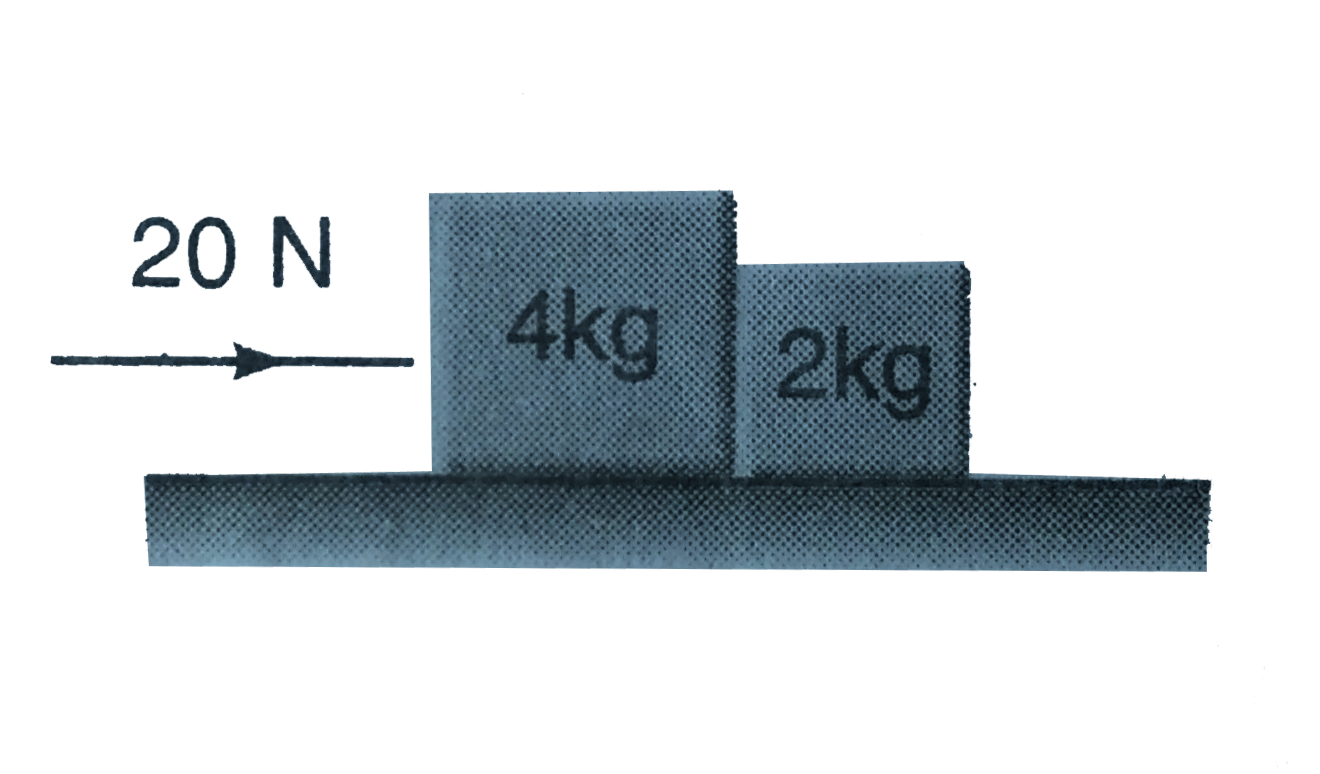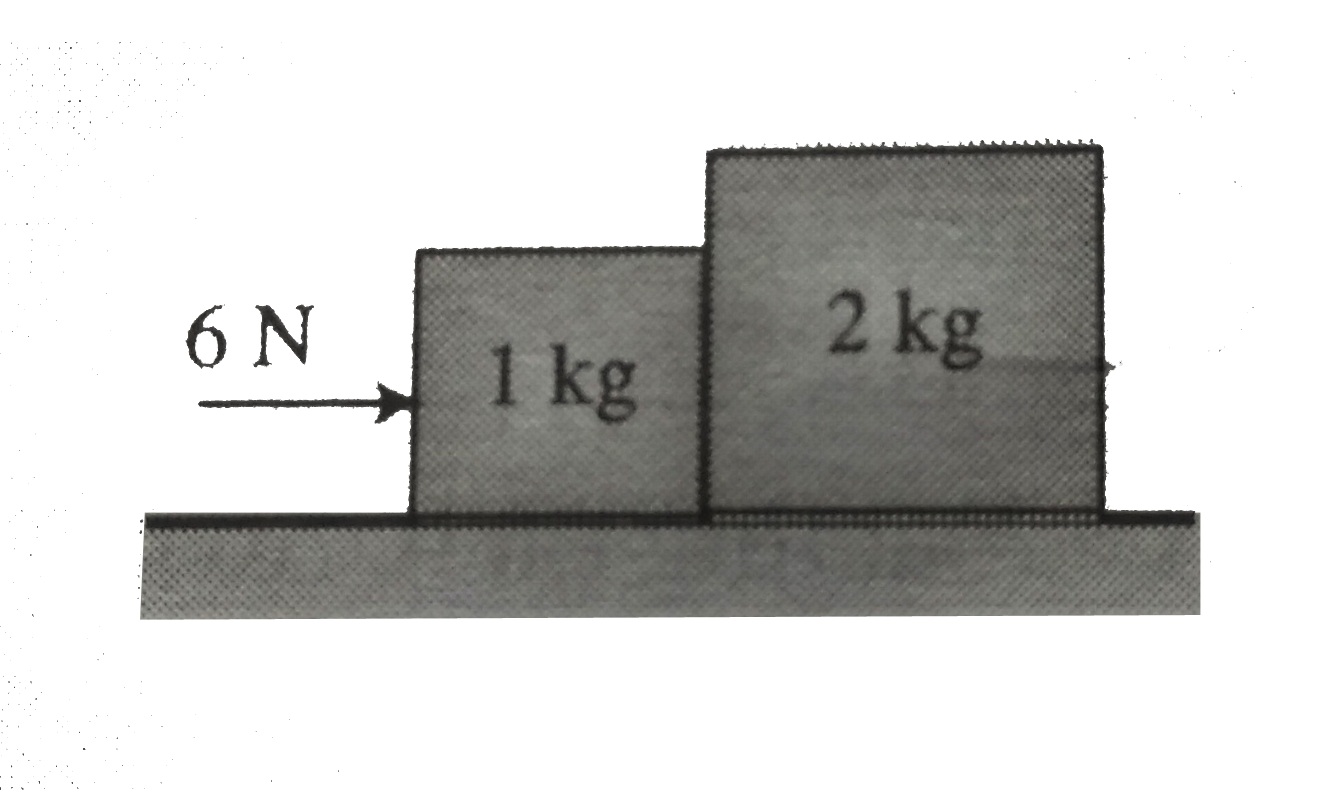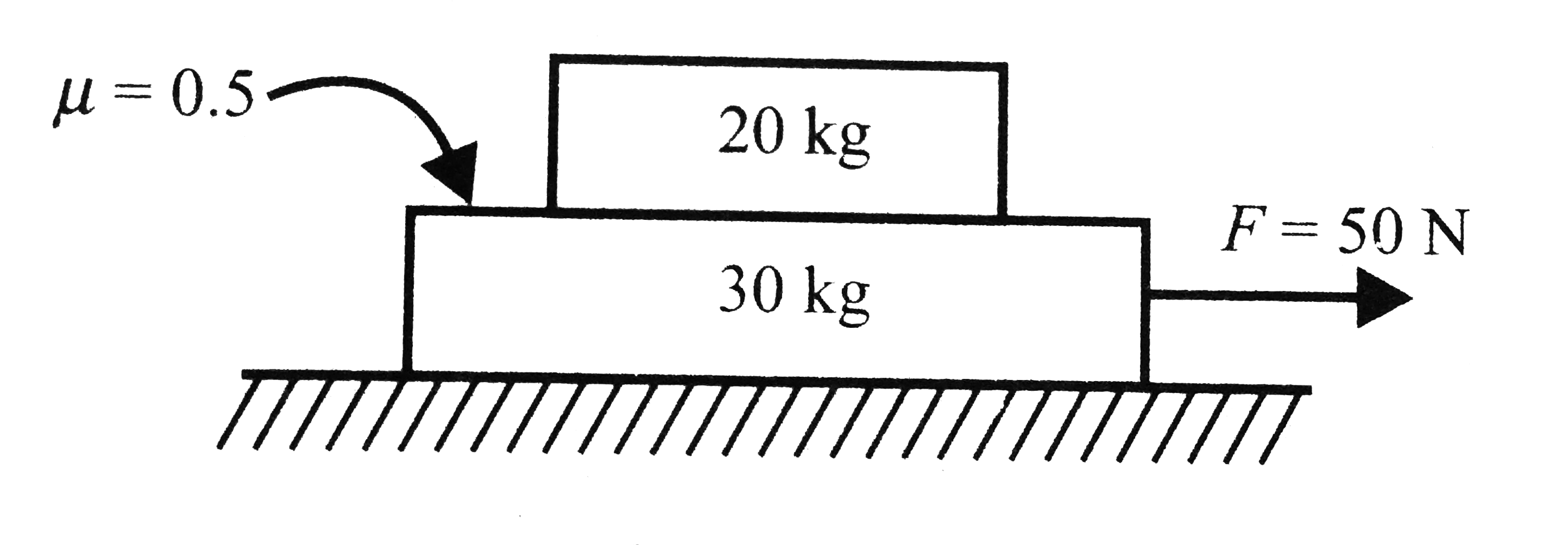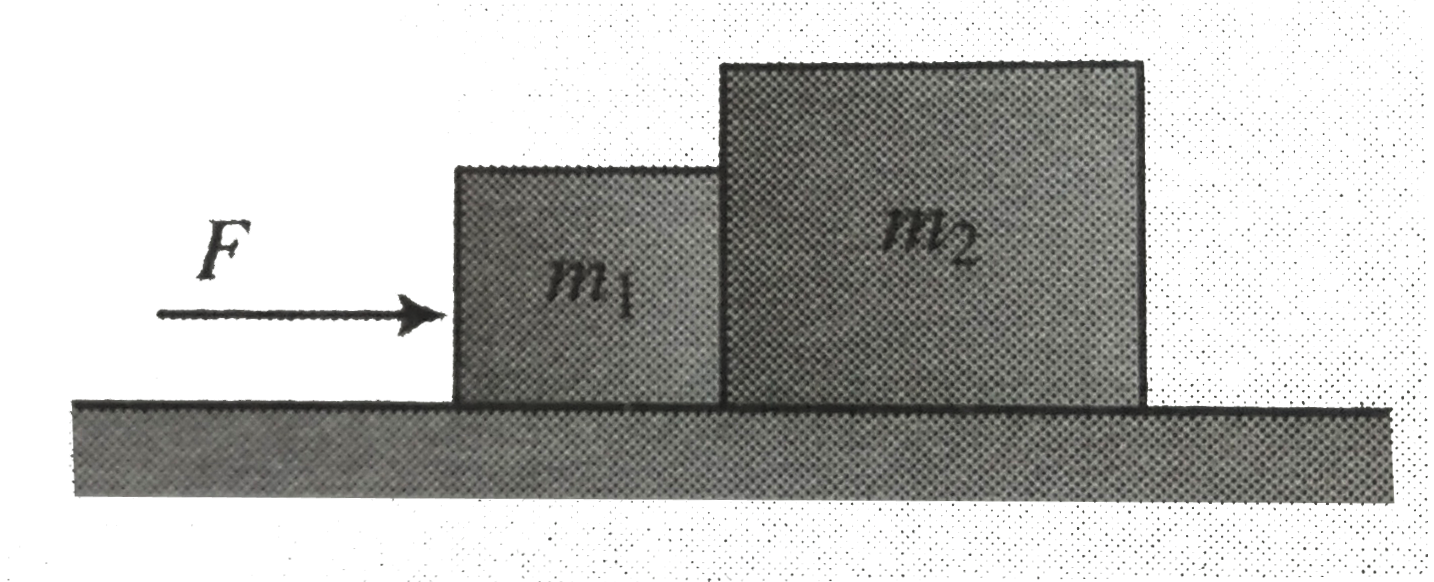For the two blocks shown in the adjacent figure, an external force of 18N is applied on the lower block. Find the acceleratiion of the upper block.
1m/s2
3m/s2
2m/s2
4m/s2
The correct Answer is:A
To find the acceleration of the upper block, we will follow these steps:
Step 1: Identify the given values
- Mass of the lower block (m1) = 4 kg
- Mass of the upper block (m2) = 2 kg
- External force (F) = 18 N
- Coefficient of friction between the lower block and the ground (μ1) = 0.2
- Coefficient of friction between the lower block and the upper block (μ2) = 0.4
- Acceleration due to gravity (g) = 10 m/s²
Step 2: Calculate the normal force on the lower block
The normal force (N) acting on the lower block due to the upper block is given by:
N=m2⋅g=2kg⋅10m/s2=20N
Step 3: Calculate the frictional force acting on the lower block
The frictional force (f1) between the lower block and the ground is given by:
f1=μ1⋅Nground=μ1⋅(m1+m2)⋅g
f1=0.2⋅(4kg+2kg)⋅10m/s2=0.2⋅6⋅10=12N
Step 4: Calculate the net force acting on the lower block
The net force (F_net) acting on the lower block is given by:
Fnet=F−f1=18N−12N=6N
Step 5: Calculate the acceleration of the lower block
Using Newton's second law (F = ma), we can find the acceleration (a) of the lower block:
a=Fnetm1+m2=6N4kg+2kg=66=1m/s2
Step 6: Determine if the upper block will slip
Now we need to check if the upper block will slip or not. The maximum static friction force (f2) between the two blocks is given by:
f2=μ2⋅N=0.4⋅20N=8N
Step 7: Compare forces to determine motion
The force required to accelerate the upper block (m2) at the same acceleration (a = 1 m/s²) is:
Frequired=m2⋅a=2kg⋅1m/s2=2N
Since the maximum static friction force (8 N) is greater than the force required (2 N), the upper block will not slip.
Conclusion
Both blocks will move together with the same acceleration. Therefore, the acceleration of the upper block is:
Acceleration of the upper block=1m/s2
- Mass of the lower block (m1) = 4 kg
- Mass of the upper block (m2) = 2 kg
- External force (F) = 18 N
- Coefficient of friction between the lower block and the ground (μ1) = 0.2
- Coefficient of friction between the lower block and the upper block (μ2) = 0.4
- Acceleration due to gravity (g) = 10 m/s²
The normal force (N) acting on the lower block due to the upper block is given by:
N=m2⋅g=2kg⋅10m/s2=20N
The frictional force (f1) between the lower block and the ground is given by:
f1=μ1⋅Nground=μ1⋅(m1+m2)⋅g
f1=0.2⋅(4kg+2kg)⋅10m/s2=0.2⋅6⋅10=12N
The net force (F_net) acting on the lower block is given by:
Fnet=F−f1=18N−12N=6N
Using Newton's second law (F = ma), we can find the acceleration (a) of the lower block:
a=Fnetm1+m2=6N4kg+2kg=66=1m/s2
Now we need to check if the upper block will slip or not. The maximum static friction force (f2) between the two blocks is given by:
f2=μ2⋅N=0.4⋅20N=8N
The force required to accelerate the upper block (m2) at the same acceleration (a = 1 m/s²) is:
Frequired=m2⋅a=2kg⋅1m/s2=2N
Both blocks will move together with the same acceleration. Therefore, the acceleration of the upper block is:
Acceleration of the upper block=1m/s2
Similar Questions
Two blocks of masses 4kg and 2kg are placed side on a smooth horizontal surface as shown in the figure. A horizontal force of 20N is applied on 4kgblock. Find
(a) the acceleration of each block.
(b) the normal reaction between two blocks.

View SolutionTwo blocks of masses 4kg and 2kg are placed side on a smooth horizontal surface as shown in the figure. A horizontal force of 20N is applied on 4kgblock. Find
(a) the acceleration of each block.
(b) the normal reaction between two blocks.

View SolutionTwo blocks of masses 1 kg and 2 kg are placed in contact on a smooth horizontal surface as shown in fig. A horizontal force of 6N is applied d(a) on a 1-kg block. Find the force of interaction of the blocks.

 .
.
View SolutionA small block of mass 20kg rests on a bigger block of mass 30kg, which lies on a smooth horizontal plane. Initially the whole system is at rest. The coefficient of friction between the blocks is 0.5. The horizontal force F=50N is applied on the lower block.

a. Find the work done by fricitonal force on upper block and on the lower block in t=2s.
b. Is the magnitude of work done by the frictional force on upper and lower blocks same?
c. Is the work done by the frictional force on the upper block converted to heat or mechanical energy or both?
View SolutionTwo block of masses m1andm2 are placed side by side on a smooth horizontal surface as shown in fig. A horizontal force F is applied on the block .

(a) Find the acceleration of each block.
(b) Find the normal reaction between the two blocks.
View SolutionThree blocks of masses 3kg,2kg and 1kg are placed side by side on a smooth surface as shown in figure. A horizontal force of 12N is applied on 3kg block. Find the net force on 2kg block.

View SolutionThree blocks of masses 3kg,2kg and 1kg are placed side by side on a smooth surface as shown in figure. A horizontal force of 12N is applied on 3kg block. Find the net force on 2kg block.

View SolutionA block of mass 10 kg is kept on a rough inclined plane as shown in the figure. A force of 3 N is applied on the block. The coefficient of static friction between the plane and the block is 0.6 What should be the minimum value of force P, such that the block doesnot move downward? (take g=10ms−2)

View SolutionA block of mass 10 kg is kept on a rough inclined plane as shown in the figure. A force of 3 N is applied on the block. The coefficient of static friction between the plane and the block is 0.6 What should be the minimum value of force P, such that the block doesnot move downward? (take g=10ms−2)

View SolutionConsider the system of 3 blocks , upon which an external frorce F is applied The force experienced by block C is
View Solution
